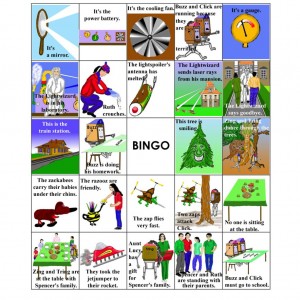
Choosing a Children’s ESL Curriculum
- Posted by Daisy Stocker
- Date August 15, 2015
- Comments 3 comments
Curriculum must be interesting and fun
The first thing that one has to realize when faced with a class of ESL children is that they are not short adults, they are something entirely different. Teaching ESL children can be extremely rewarding, and all kinds of fun, but having an interesting and effective curriculum is all important.
Learning by Context
Children are quite expert at learning by inference. They can deduce the meaning of a word in a sentence by the context. This comes naturally to them, because this is how they first
learned their native tongue as babies. I once showed the children in a class a picture of myself in front of an ancient cedar tree. I asked them if the tree was bigger than me. As I said “bigger”, I swelled out my chest and stood tall. In no time at all the children agreed that the tree was bigger then me. Then I asked them if it was older than me. On the word “older”, I hunched over. Very soon the answer came back: “Yes, the tree is older than you.” That evening I repeated the experiment with a class of adults. The only answers I got were “Hey George, what’s this “bigger” stuff,” and “what’s this “older” stuff?” Children will infer the meaning from the context, but adults have to know the reasons behind things before they will take a chance.
Enjoying Classes
In Budapest, we taught ESL to children in volunteer after school classes. At first we had about 16 students each, which was fine. But then, when the classes grew to 18, we became alarmed and spoke to the teacher involved. She said: “Don’t worry, lots of them will drop out right away.” Well, they didn’t drop out. The classes kept growing, until we were teaching about 22 students each class. If children have a good curriculum to work from, they will enjoy their classes and will want to come back and learn more.
Songs and Verse
Many children love to sing. If, as a teacher, you feel that you don’t have the talent to lead the class in song, reciting verse is just as effective. Although this may seem frivolous to some people, I suggest that you think of a verse and a song that you learned as a child. The first is about the days of the months: “Thirty days has September…” The second is the Alphabet Song. This verse and this song were learned by most children, and they are retained for the rest of their lives. So song and verse can be effective learning tool.
Fun Activities
Sitting in one place doing the same thing over and over is not a natural situation for a child. They need movement and a variety of activities to keep them interested, (and learning.) The following are some activities that we found useful in teaching ESL children.
 Bingo Games
Bingo Games
Children love to play Bingo and they will work hard if they know that there will be a Bingo Game at the end of the class. The younger ones will play best with Picture Bingo, while the older children can play Word Bingo.
Bingo Games with complete instructions are included in our Children’s ESL textbooks or you can buy separately from our ESL Activities page (Bingo for Adults)
Crossword Puzzles
 Crossword puzzles can be used as part of the lesson, as homework assignments, or can be given to children who finish their work early. The competitive spirit within most children will motivate them to work hard to solve the puzzles.
Crossword puzzles can be used as part of the lesson, as homework assignments, or can be given to children who finish their work early. The competitive spirit within most children will motivate them to work hard to solve the puzzles.
An ESL curriculum that uses these methods is sure to encourage children to be successful with their lessons, and you are likely to have happy children in your classes!
Teaching Children ESL Articles
- Teaching the English Alphabet to Children - Books -- Songs -- Teaching Alphabet Elements -- Names and Sounds -- Uppercase and Lowercase -- Shapes and Sounds Teach letter names in lowercase and uppercase. This helps children recognize and familiarize themselves with the …
- Children’s Learning Problems and Suggestions for Helping Them - Wherever you are teaching, it’s likely that you have one or two children who disrupt the class or are withdrawn from the group. These students require extra teacher time. They …
- Tips for Building Confidence in Young Children - Let’s assume you’re teaching rhyming words to your ESL class. Some of the children are interested in your rhyming words lesson but others aren’t participating. Perhaps they are shy, frightened …
- Motivating Young Children to Learn English - Motivating Children in Difficulty or Boring SubjectsLet’s assume that the children have had time to settle into the classroom environment and that you are ready for them to begin the …
- Get Kids Interested and Excited About Learning English - English Foreign Language classes can accelerate learning if they offer exciting stories for the children to enjoy. People of all ages need to be interested in what they are studying. …
- Developing Listening Comprehension in Children - If English Second language children are interested and actively involved in what they are doing, they will learn to understand English. This article will present a type of activity that …
- Building English Language Confidence in Children - Let’s assume you’re teaching rhyming words to your Children’s ESL EFL class. Some of the children are interested in your rhyming words lesson but others aren’t participating. Perhaps they are …
- Choosing a Children’s ESL Curriculum - The first thing that one has to realize when faced with a class of ESL children is that they are not short adults, they are something entirely different. Teaching ESL …
- Suggestions for Cutting Costs in Providing Your Children’s ESL Curriculum - The world has entered a period of difficult times. Millions of people have lost their jobs, companies that have had many years of success are closing their doors and people …
Date Published: 2015-08-15
Date Modified: 2024-04-11
Daisy Stocker taught ESL in Eastern Europe for 10 years and was a primary school teacher in Canada for 30 years. Daisy has a B.A. and M Ed. in Education.
You may also like
Teaching the English Alphabet to Children
Books — Songs — Teaching Alphabet Elements — Names and Sounds — Uppercase and Lowercase — Shapes and Sounds Teach letter names in lowercase and uppercase. This helps children recognize and familiarize themselves with the …
Wherever you are teaching, it’s likely that you have one or two children who disrupt the class or are withdrawn from the group. These students require extra teacher time. They …
Tips for Building Confidence in Young Children
Let’s assume you’re teaching rhyming words to your ESL class. Some of the children are interested in your rhyming words lesson but others aren’t participating. Perhaps they are shy, frightened …

3 Comments
I have been thinking about this since I read it Ben. The part that retenasos with me most is that these kids live with challenging life circumstances and most don’t want to be there. I forwarded it to an amazing Outreach Principal and friend of mine but she is so overworked presently, that she may not get back to it. My first thought is to go back to Dr. Brokenleg’s work with youth at risk and look at ways to make certain that each child feels that they belong there. Maybe through the use of Storify or some such simple and quick webtool, each can express his/her feelings about such challenges. Kaye, my principal friend, has relied on kids to build classroom shelves, taught them how to answer the class phone properly when she is busy, taken them to garage sales to purchase necessary needs for their living conditions, etc. etc. and once the relationship is solid, has successfully helped many graduate! Or, my daughter spent 10 days with a class of Japanese students where only one spoke English and she helped them express through song and sport??? I’ve been thinking so much about this and just wanted to throw a few things out there. Keep us posted! Ellyn
I loved when you mentioned how you should consider using music when looking for the best ESL classes. It is important to remember that doing this and taking the time to look for the best classes you can find will help you learn English right. My mom wants to move to the United States and wants to learn English as fast as she can, so I’m glad I found your post.
Thank you for helping people get the info they need. Great stuff as always. Keep up the great work!!!